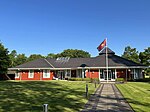Sunbury Lock

Sunbury Lock is a lock complex of the River Thames in England near Walton-on-Thames in north-west Surrey, the third lowest of forty four on the non-tidal reaches. The complex adjoins the right, southern bank about 1⁄2 mile (0.80 km) downstream of the Weir Hotel. The complex is two locks, old and new, and a narrow concrete divide, which are downstream of the original lock built in 1812. The older, hand-operated, was originally built in 1856, seldom used. The newer was opened in 1927 by Lord Desborough. Rollers and a slope adjoins for the portage (hauling) of small boats. The lock adjoins Sunbury Lock Ait. The lock has three associated weirs, upstream. The main weir is between Sunbury Lock Ait and Wheatley's Ait (north); the latter has two other weirs, one is a small part-time storm weir.
Excerpt from the Wikipedia article Sunbury Lock (License: CC BY-SA 3.0, Authors, Images).Sunbury Lock
Thames Street,
Geographical coordinates (GPS) Address Nearby Places Show on map
Geographical coordinates (GPS)
| Latitude | Longitude |
|---|---|
| N 51.405138888889 ° | E -0.40611111111111 ° |
Address
Thames Street
TW16 6AE
England, United Kingdom
Open on Google Maps








